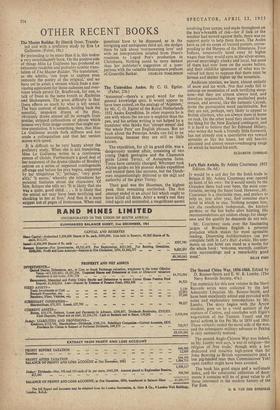The Untrodden Andes. By C. G. Egeler. (Faber, 25s.) 'ANDINIsM'—there's
a good word for the general knowledge quiz. It would appear to have been coined, on the analogy of 'Alpinism,' by Mr. C. G. Egeler of the Royal Netherlands 1952 Andes Expedition. In other respects he is one with whom the ice-axe is mightier than the pen, and his artless writing is not helped by a translator who thinks that 'abrupt steeps' and 'the whole Peru' are English phrases. But no book about the Peruvian Andes can fail to be interesting, because they are still so little known.
The expedition, for all its grand title, was a dangerously modest affair, consisting of two young Dutch geologists and the Chamonix guide Lionel Terray, of Annapurna fame. Times have certainly changed; Whymper took Alpine guides on his pioneer Andes expedition and treated them like servants, but the Dutch- men unquestioningly deferred to the skill and authority of the great Terray.
Their goal was the Huantsan, the highest peak then remaining unclimbed. The first attempt ended in an abseil fall which ought to have killed all three. After a week's rest they tried again and succeeded, a magnificent ascent
involving four camps, and made throughout on the hair's-breadth of risk—for if luck or the weather had turned against thetn, there was no support party to help them down. The Andes have as yet no corps of trained porters, corres- ponding to the Sherpas of the Himalayas. Four Indians, temporarily lured away by higher wages than they would earn in the silver-mines. proved surprisingly plucky and loyal, but none of them had ever been on the snows before, and their childlike ignorance of what was in- volved led them to suppose that there must be houses and shelter higher up the mountain.
Andinism consists, we learn, almost entirely of snow and ice work. Not that rocks fail to outcrop on mountains of such terrifying steep- ness—but they are almost always iced, and therefore impassable. Many unclimbed peaks remain, and several, like the fantastic Cayesh, invite the provocative word uoclimbable. But they are not, perhaps, very likely to appeal to British climbers, who are always most at home on rock. On the other hand they should be just the thing for the New Zealand contingent, and it is hard to believe that Sir Edmund Hillary, who writes the book a friendly little foreword, has not already cast a speculative eye toward summits so like the lesser, but still heavily glaciated and almost ocean-overhanging range on which he learned his craft.
ELIZABETH COXHEAD










































 Previous page
Previous page